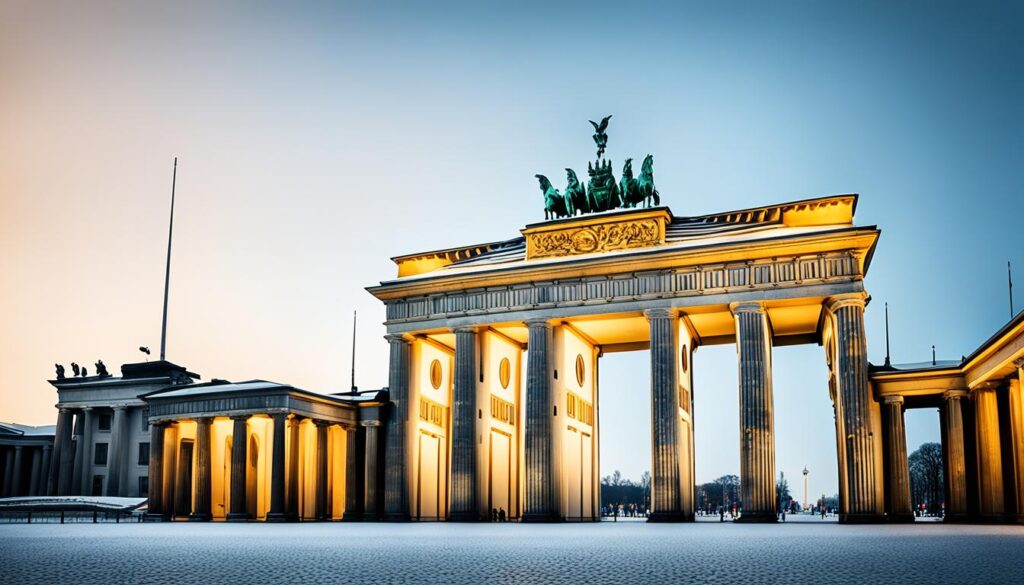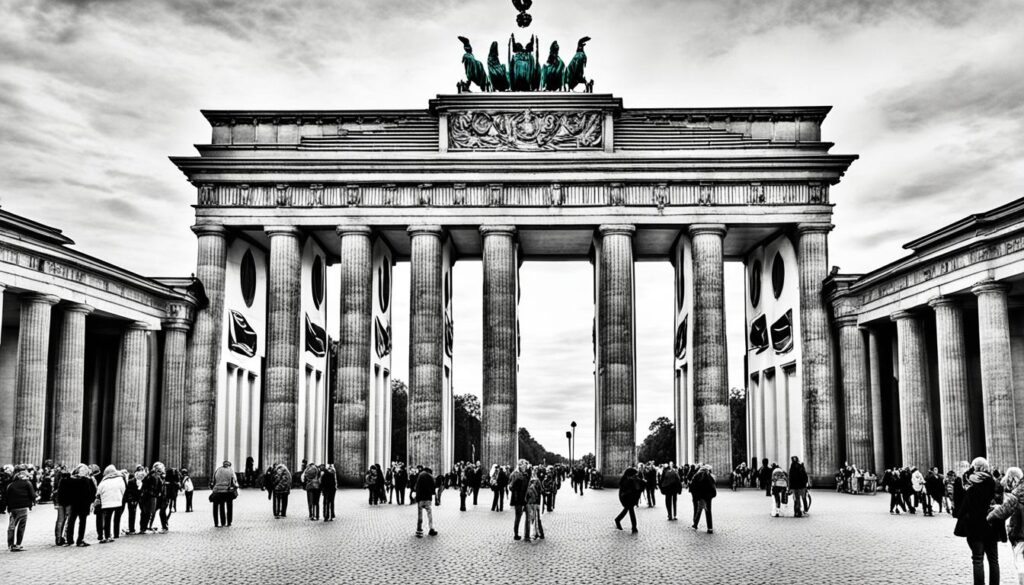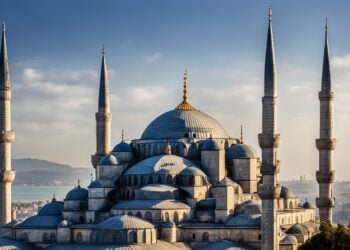The Brandenburg Gate is a key landmark in Berlin, Germany. It symbolizes the country’s tumultuous past and its victory over hard times. This Neoclassical masterpiece from the 18th century has seen empires rise and fall. It has been there for the division and reunification of a nation.
Visiting the gate is a must for anyone in Berlin. It’s a chance to dive into the rich history and stunning architecture of this place. It’s truly one of Europe’s true cultural wonders.
Cultural Wonders: Unveiling Berlin’s Iconic Landmark
The Brandenburg Gate is more than just a Berlin landmark. It’s a symbol of Germany’s past, standing tall through tough times. Its neoclassical design shows German unity and strength. People from all over come to see its beauty and importance.
The Enduring Symbol of Germany’s Tumultuous Past
The Brandenburg Gate has seen many changes in history. It was once a sign of Prussia’s strength, then a symbol of division during the Cold War. The Berlin Wall once separated it from the West, but it never lost hope. It showed the German people’s strong spirit.
A Marvel of Neoclassical Architecture
Created in the late 1700s, the Brandenburg Gate is a masterpiece of neoclassical architecture. Its design is symmetrical, with big columns and a grand top. It’s a key spot for those wanting to see Berlin’s culture and Germany’s history.
An Architectural Masterpiece: Deconstructing the Gate’s Design
The Brandenburg Gate in Berlin is a stunning example of Neoclassical architecture. It shows the incredible craftsmanship and artistry in its making. This iconic landmark has a grand, symmetrical design. It also has 12 Doric columns that support a beautiful attic and a chariot-crowned gate.
Looking closely at the Brandenburg Gate’s design shows its architectural mastery. It’s one of the most recognizable landmarks in Berlin and a true cultural wonder. The gate’s details, like the bas-relief sculptures and the iconic quadriga statue, show the skill and attention to detail in its creation.
The Neoclassical design of the Brandenburg Gate reflects Berlin’s artistic and architectural traditions. This landmark stands as a symbol of the city’s rich history and its lasting legacy as a center of culture and creativity.
By examining the Brandenburg Gate’s architectural features, visitors can appreciate the skill and vision behind it. From the imposing Doric columns to the intricate bas-relief sculptures, each part of the gate’s design adds to its grandeur and significance as a Berlin landmark.
From Ancient Origins to Modern Rebirth
The Brandenburg Gate in Berlin has a long history, dating back to the 18th century. It was built by Prussian King Frederick William II as a grand entrance to the city. Over time, it has seen many changes, becoming a symbol of Prussia’s strength and later, a symbol of division during the Cold War.
The Gate’s Storied Evolution Through the Ages
During the Cold War, the Brandenburg Gate was right on the Berlin Wall. It reminded people of the divide between East and West Germany. But it didn’t give up. After the Wall fell in 1989, it was carefully restored. Now, it stands as a symbol of German unity and cultural heritage.
The Brandenburg Gate is loved not just in Berlin but worldwide. Its journey through history shows its importance in German culture. It draws visitors with its beautiful design and deep meaning as a Berlin landmark.

Now, the Brandenburg Gate is a symbol of unity and strength. It shows how people can overcome big challenges. Its change from a symbol of division to one of unity shows the German spirit. This cultural icon continues to hold great importance.
A Gateway to Berlin’s Vibrant Culture and Heritage
The Brandenburg Gate is more than just a landmark. It opens the door to Berlin’s rich culture and history. Around it, you’ll find attractions that highlight the city’s diverse heritage and lively spirit. Visiting these spots is key to experiencing Berlin fully.
Exploring the Surrounding Landmarks and Attractions
Close to the Brandenburg Gate is the Reichstag building, where the German parliament meets. It’s a symbol of the nation’s political past. Near it, the Memorial to the Murdered Jews of Europe honors those lost in the Holocaust. In Tiergarten park, you can see the city’s Prussian heritage and enjoy a peaceful break.
Beyond the Brandenburg Gate, Berlin’s culture is everywhere. Art galleries, museums, and cultural spots abound. The Pergamon Museum and Berggruen Museum are just the start, offering a deep dive into art and history.
Among these landmarks, Berlin’s streets and neighborhoods add to its charm. You can walk through Mitte’s buzz, shop in Prenzlauer Berg’s trendy spots, or check out Kreuzberg’s street art and nightlife. Each area shows off German culture in its own way.
Exploring beyond the Brandenburg Gate reveals Berlin’s full heritage. From its Prussian roots to its Cold War history and modern cultural scene, the city’s vibrant culture and history are waiting to be discovered.
Iconic Moments in Brandenburg Gate’s Illustrious History
The Brandenburg Gate is a key landmark in Berlin. It has seen major events in German history. This grand neoclassical structure has been a symbol of the nation’s highs and lows.
In the Prussian era, the gate was where grand military parades took place. These parades showed the strength of the German empire. The gate’s design was perfect for these displays of national pride.
But, the gate’s history isn’t all bright. During the Cold War, it symbolized the division of Berlin. It was a reminder of the city’s split.
In 1987, President Ronald Reagan gave a famous speech at the gate. He asked Soviet leader Mikhail Gorbachev to “tear down this wall.” This moment called for German reunification and the end of the Cold War.
The gate has also seen celebrations and protests. These events show the changing culture and politics of Germany. From the Berlin Wall’s fall in 1989 to the annual Festival of Lights, the gate has been a symbol of unity and freedom.
Cultural Significance and Role in Unifying Germany
The Brandenburg Gate in Berlin is a symbol of German unity and freedom. During the Cold War, it stood on the border between East and West Berlin. It showed the division of the country.
But with the fall of the Berlin Wall in 1989, the Brandenburg Gate became a symbol of German reunification. It showed the power of the human spirit and the strength of liberty.
Today, the Brandenburg Gate stands as a symbol of Germany’s cultural heritage. It shows the country’s commitment to unity and democracy. Its beauty and history make it a beloved landmark for Germans and visitors worldwide.
Its legacy as a symbol of German freedom and identity is huge.
Symbolic Representation of Unity and Freedom
The Brandenburg Gate’s role in unifying Germany comes from its history. During the Cold War, it was on the border between East and West Berlin. This made it a symbol of division.
But with the fall of the Berlin Wall, it became a beacon of hope. It showed the reunification of Germany and the return of freedom.
Since then, the Brandenburg Gate has reminded Germany of its shared culture and commitment to democracy. People from all over the world visit this iconic landmark. They come to see its beauty and learn about the German people’s strength and unity.

Capturing the Gate’s Grandeur: Photo Opportunities Galore
The Brandenburg Gate in Berlin is a dream spot for photographers. It’s full of chances to capture its grand beauty. No matter if you’re a pro or just starting, this landmark is perfect for amazing photos.
The gate’s design is symmetrical and neoclassical, with detailed architecture. Every view offers a great shot. Against the Berlin skyline or in the evening light, it’s a sight photographers love.
Berlin’s landmarks, like the Brandenburg Gate, are great for cultural and architectural photos. Its grandeur and history make it a top spot for photographers. It’s a key place to see the city’s vibrant culture and beauty.
Visiting the Brandenburg Gate: A Must-Do on Any Berlin Itinerary
Exploring the iconic Brandenburg Gate is a key part of any trip to Berlin. It sits in the city’s heart, offering a peek into Germany’s history and today. This cultural landmark lets visitors dive deep into the country’s past and present.
Plan your visit to the Brandenburg Gate for early morning or late afternoon. This way, you can enjoy the gate’s beauty without the crowds. Don’t forget to check out nearby tourist attractions like the Reichstag building and Tiergarten park. This makes your Berlin travel guide experience richer.
Tips for an Unforgettable Experience
When you’re at the Brandenburg Gate, remember to:
- Arrive early or late to avoid crowds and enjoy peace
- Spend 30-60 minutes exploring the gate and its area
- Bring a camera to capture the gate’s stunning architecture and lively atmosphere
- Think about visiting the Tiergarten park or the Reichstag building too
Follow these tips for an unforgettable time at the Brandenburg Gate. It’s a top spot in Berlin, loved by many and a key part of any Berlin travel guide.
The Future of the Brandenburg Gate: Preserving a Global Icon
The Brandenburg Gate is a symbol of history and beauty. It’s a challenge to keep it safe for the future. Efforts are made to keep its Neoclassical beauty. This includes regular upkeep and restoration to fight against weather and pollution.
Its cultural importance is also being protected. Educational programs and initiatives show its role in German unity and global culture. By keeping the Brandenburg Gate safe, Berlin and the world make sure it stays a symbol of inspiration for all.
Preserving the Brandenburg Gate is about more than just its looks. It’s about keeping alive the spirit of unity, freedom, and cultural exchange. As a symbol known worldwide, its future is tied to Berlin’s heritage. This ensures it will continue to amaze and inspire people everywhere.






